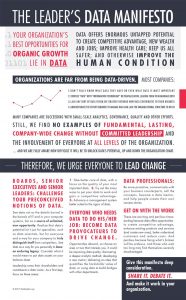 Obviously, data management is important. Unfortunately, it is not prioritized in most organizations. Those that effectively manage data perform far better than organizations that don’t. Everyone who needs data to do his/her job must drive change to improve data management.
Obviously, data management is important. Unfortunately, it is not prioritized in most organizations. Those that effectively manage data perform far better than organizations that don’t. Everyone who needs data to do his/her job must drive change to improve data management.
That was the theme of the recent Enterprise Data World (EDWorld) conference this week. This year’s EDWorld event might be the start of a new vitality and influence for the field, marked by introduction of a Leader’s Data Manifesto.
Over the years, data practitioners struggled for recognition and resources within their organizations. In reaction, they often focused on data “train wrecks” that this neglect causes. This year’s conference was no exception. For example: Continue reading





 Yesterday I had the pleasure of presenting “The Business End of Data Modeling” for the Lynchburg SQL Server User’s Group. It was a great time, thanks for having me out!
Yesterday I had the pleasure of presenting “The Business End of Data Modeling” for the Lynchburg SQL Server User’s Group. It was a great time, thanks for having me out!
